Quick search
CTRL+K
Quick search
CTRL+K
Ierapetra, the southernmost city of Greece, is nestled 35km southeast of Agios Nikolaos on Crete island. This city, located in one of the warmest regions of Crete, is a popular holiday destination, often frequented until late autumn. Ierapetra and its surrounding areas boast a vast beachfront, renowned for its stunning beaches adorned with unique fine black pebbles that do not stick to your feet, coupled with a typically calm sea.
In proximity to the town, there are three primary beaches for swimming. Starting from the west, the first is Limanakia, situated west of the city next to the old mosque. The beach features coarse sand, patches of a rocky seabed, and shallow waters, offering a peaceful atmosphere. Given its closeness to the city, all necessities are readily available. Limanakia also hosts a channel in the middle of the beach that leads to a small man-made salt lake.
A short stroll eastward will bring you to the Fort of Kales, which guards the harbour of Ierapetra. Adjacent to it is Apovathra Beach, a sandy beach with shallow waters. This beach is well-equipped with numerous facilities for water sports and scuba diving, making it the most organized beach in the town.
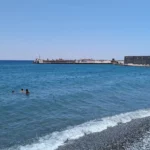
The city of Ierapetra, in close proximity to the Agia Fotini church, boasts the longest beach which spans 4km eastwards and is known as the East Beach of Agios Andreas. The name is derived from the Saint Andrew church, constructed at the exit point of the Kotovianou river. Initially, you will encounter the municipal beach, well-structured and surrounded by numerous large hotels. However, as you venture further east, the beach becomes more private. Despite this, it’s not suitable for nudists due to the main road that connects the city with Makrigialos and Sitia along the coast. The beach near the city center is sandy, but as you advance east, the sand gives way to small, grey pebbles and rocks, particularly up to the Livadia area.
The easternmost point of the extensive Ierapetra beach is known as Livadia, and beyond that, is named Peristeras. This secluded region is enveloped by towering cliffs. The beach itself is sandy, interspersed with several smooth rocks. The farthest part of Agios Andreas can be accessed by walking down the road. In addition to this, there is another sandy beach hidden behind the rocky end of the expansive beach in Peristeras, which can be reached via the road. This area is significantly shielded from onlookers, however, it’s quite rocky.
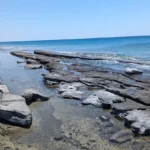
Gra Ligia is a coastal village located a short 5km journey to the west of Ierapetra and a 39km trip south from Agios Nikolaos. Nestled at the mouth of a rich valley, the village is surrounded by greenhouses filled with early-ripening vegetables. The locals of Gra Ligia were pioneers in the use of greenhouse agriculture, a practice that has since spread throughout the Ierapetra region. The profusion of greenhouses has even earned the village the nickname of “Silicon Valley of Greece”. The Bramiana dam, situated 2km north of the village, plays a crucial role in the area’s agriculture, supplying water to all Ierapetra crops and forming one of Crete’s key wetlands.
Aside from farming, tourism also forms an essential part of the local economy. Gra Ligia, with its recent mild growth, is among the newest holiday destinations on Crete. This growth has been facilitated by the appealing long beach, fringed with coarse sand that extends from Ierapetra to the Stomio region. The beach is known for its tranquil waters and is well-equipped with amenities like umbrellas and showers, albeit not on a large scale. Tamarisk trees pepper the landscape, providing shade and greenery. The beach is a popular spot for locals who enjoy swimming and fishing from their boats docked in the local harbour.
The beach is also a venue for local events such as beach soccer tournaments. If you’re fortunate, you might even have a chance to partake in the unique “xentomatiasmata” or tomato war, a tradition revived and celebrated in early summer. Gra Ligia is an ideal destination for those seeking a peaceful and relaxing holiday. In the evenings, visitors can unwind with a drink at local bars or take a short trip to Ierapetra. To reach Gra Ligia from Ierapetra, simply travel westward on the city road. Alternatively, there are bus services that pass through the village.

Just past the Peristeras suburb of Ierapetra begins the Katharades area, a chain of small beaches leading up to the popular coastline of the Koutsounari village. Known for its strong winds, it’s considered one of Crete’s windiest locations. The bays of this area are somewhat hidden, despite their proximity to the main road, leading to few visitors to the sequential bays. The area also goes by the name Paplinou, due to the nearby ancient Panagia Paplinou monastery.
The stunning landscape is shaped by numerous rock shelters and unique rock formations, a product of erosion on the conglomerate soil over time. There’s been a slight increase in development in recent years, mainly due to the construction of large hotels near the coast. Consequently, the main road between Ierapetra and Makrygialos boasts a few restaurants, mini markets, and accommodations.
The beach features coarse grey sand, and its seabed has large, smooth rocks interspersed with sandy areas. The surrounding area is dotted with tamarisk trees offering shade, and umbrellas are also available. The beach is well maintained by the nearby hotels and features a beach volleyball court, sunbeds, showers, and water sports facilities.
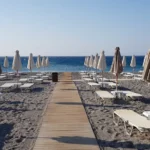
Koutsounari, a quaint seaside hamlet, lies 6km east of Ierapetra and 43km southeast of Agios Nikolaos. It nestles near the scenic village of Agios Ioannis, set against the backdrop of the Thripti Range. The village is perched on a verdant hill, surrounded by olive groves and pine trees, just a kilometer north of the South Cretan Sea coastline.
A kilometer to the south of Koutsounari is the expansive Long Beach of Agios Ioannis, stretching 5km, one of the longest in Crete. This broad, serene beach features the distinctive coarse grey sand typical of southern Crete. In many spots, tamarisk trees punctuate the landscape, and their length makes the beach appear deserted. The beach is somewhat organized in certain areas (near hotels) and is dotted with hotels, restaurants, mini markets, and a camping site.
If you venture eastward along the beach, you’ll encounter fewer swimmers. On the eastern end of Long Beach, a bay known as Psaropoula (named after an old local tavern) is shaped. Psaropoula features soft sand and tranquil waters, situated in front of a hotel, it is well-equipped with umbrellas, sunbeds, showers, and water sports. The sea here is typically calm, and the rocky seabed makes it a suitable spot for snorkelling.
Beyond Psaropoula lies another small cove boasting a well-appointed beach with umbrellas, showers, and water sports. This beach, located in front of the Kakkos Bay hotel, is called Villa Despot, translating to “Priest’s Villa” in Greek, named after a priest-owned building nestled between the two beaches. The beach is flanked by large rocks that provide a perfect spot for diving into the sea.
Visiting Long Beach in autumn offers a sight of the rare white sand lilies, signaling the summer’s end. These lilies are protected, so visitors are encouraged to appreciate their beauty from a distance without touching or picking them.

Ammoudares, a seaside location 8km west of Ierapetra and 45km south of Agios Nikolaos, shares its beachfront with nearby Nea Anatoli and Stomio. The Ammoudares coastline features a series of long beaches with coarse grey sand. They are mostly uncrowded and secluded, largely due to the surrounding greenhouses which may deter visitors due to potential pesticide use in the waters.
A kilometer east of the initial Ammoudares beach, you’ll encounter Kalamaki beach. Hidden from the main road and largely undiscovered by tourists, its sandy shores are a quiet haven. It’s also referred to as Kapelas, named after a renowned pizzeria once run by an American in the area. Kapelas translates to ‘tavern owner’ in Greek. The beach is nestled amidst towering cliffs adding to its tranquility.
Access to both Ammoudares and Kalamaki is possible via the main road from Ierapetra heading west. If you’re fortunate to visit the Ierapetra vicinity, there are numerous appealing beaches that warrant exploration. However, if solitude is what you’re seeking, both Ammoudares and Kalamaki offer a peaceful retreat.

Situated 46km southeast of Agios Nikolaos and 9km east of Ierapetra, lies the charming beach of Kakia Skala. The beach, moderately developed, is conveniently positioned alongside the main road that links Ierapetra with Makrigialos. It is uniquely set at the terminus of the majestic Agios Ioannis Gorge, which is home to Milonas waterfalls. The beach is adorned with fine pebbles and provides a serene environment with its crystal clear, calm waters. There’s no need for umbrellas, as ample shade can be found under the tamarisk trees.
The locals often refer to this area as Kakkos, named after the nearby Kakkos Bay hotel, which is a mere 200m westward.

Ferma, a small coastal town, is situated 10km to the east of Ierapetra and 45km to the southeast of Agios Nikolaos, lying 4km south of the village, Agios Ioannis. The area is green and verdant, with dense pine forests, a stark contrast to the arid landscape of Eastern Crete. A string of tiny bays stretches along the coast, the largest being Livadi, also known as Ferma beach or Xerokamara. This beach, flanked by hotels, boasts fine pebbles, clear deep waters, and is bordered by lush vegetation and towering smooth rocks and steep cliffs.
Access to the unorganized beach is through two stairways starting from the nearby hotels. The beach features several springs and a small clump of Cretan Date Palm in its center. Following Livadi is Pigadi beach, named after a structure resembling a well. It, along with an adjacent small bay, can be reached via a stairway from the main road. The last beach in the area, Giorgakis, is similarly accessed via a steep path with iron stairs.
Ferma is known for its tranquil ambiance, making it an ideal spot for families to bask in the sun and enjoy the sea, with basic amenities within a short walk. If you’re visiting Ferma, ensure to explore the lush nature around. Check out the village of Agios Ioannis, stroll through its narrow lanes and churches, and visit the springs of Psychro and the Agios Ioannis waterfalls in the Milonas gorge.
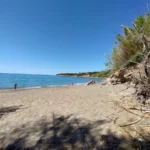
Situated about 10km east of Ierapetra and 45km southeast of Agios Nikolaos, within the vicinity of the Agios Ioannis village, lies the beautiful Giorgakis beach. This stunning beach is nestled in the Ferma area, a region renowned for its numerous beaches. Despite being surrounded by towering cliffs, you can reach the beach via stairs originating from the Ferma Solaris Hotel. Once you descend, you’ll find yourself on one of the most picturesque beaches in East Crete, adorned with fine pebbles, rocks, and naturally formed caves.
The beach is segmented into two sections by a low-lying rock. The smaller western beach is the outlet of a local stream that meanders from the Strongyli peak region. Before reaching the beach, the stream creates a stunning waterfall, about 10 meters in height, which showcases vibrant rocks and dries up during the summer.
Ferma’s broader area is a lush oasis within the typically dry landscape of Eastern Crete, enveloped by pine trees and dense vegetation. Nearby, you’ll find several freshwater springs that continue to drip, even in summer, promoting the growth of such lush greenery.

Kamini, situated near the renowned Minoan settlement of Gournia by Pahia Ammos, is an enchanting location composed of five sequential pebble beaches. Positioned north of the archaeological site, Kamini was most likely Gournia’s access point to the sea, explaining the presence of Minoan structures in the area, such as remnants of rooms, walls, and ship sheds or boathouses. The Gournia necropolis is also found in this area.
Kamini’s natural allure is as significant as its archaeological value. The coastline, adorned with limestone conglomerates and strikingly red soil, presents a stunning display of colors. The area boasts intriguing geological formations, sea caves, rock bridges, and five beaches speckled with fine or coarse pebbles. However, some of these beaches can be difficult to access.
Regrettably, the north winds often bring a disheartening amount of trash from across the Aegean Sea, littering the otherwise pristine landscape. This, coupled with the strong winds, tends to deter visitors. However, when the winds shift to the south, Kamini’s true splendor emerges, with turquoise and crystal-clear waters that truly are a sight to behold.
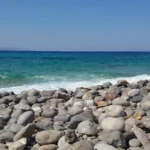
No results available
Reset© All rights reserved. Crete Locals